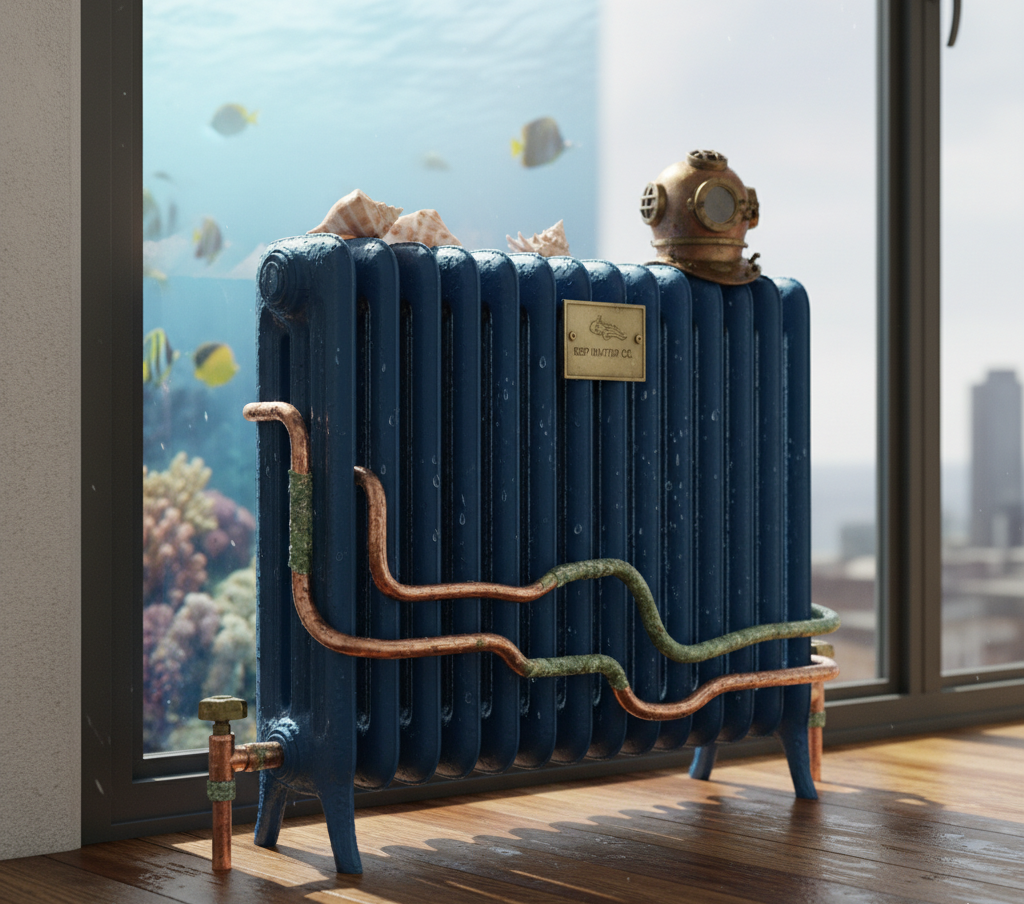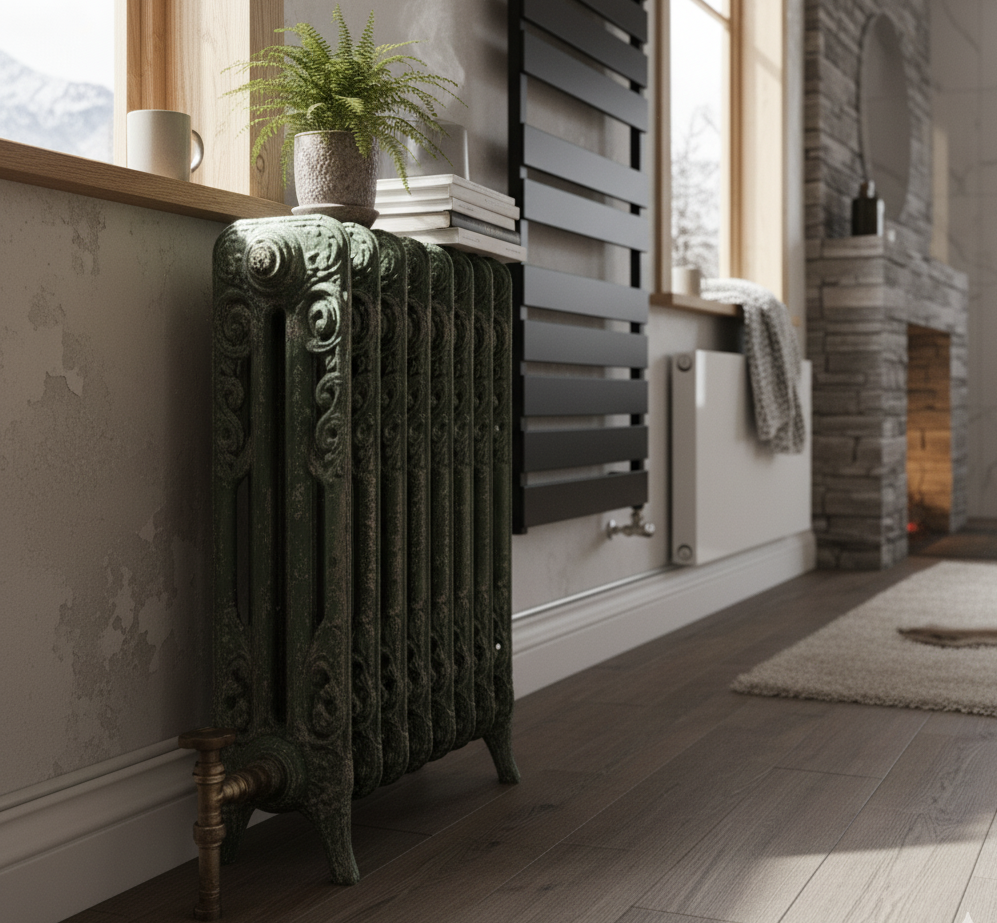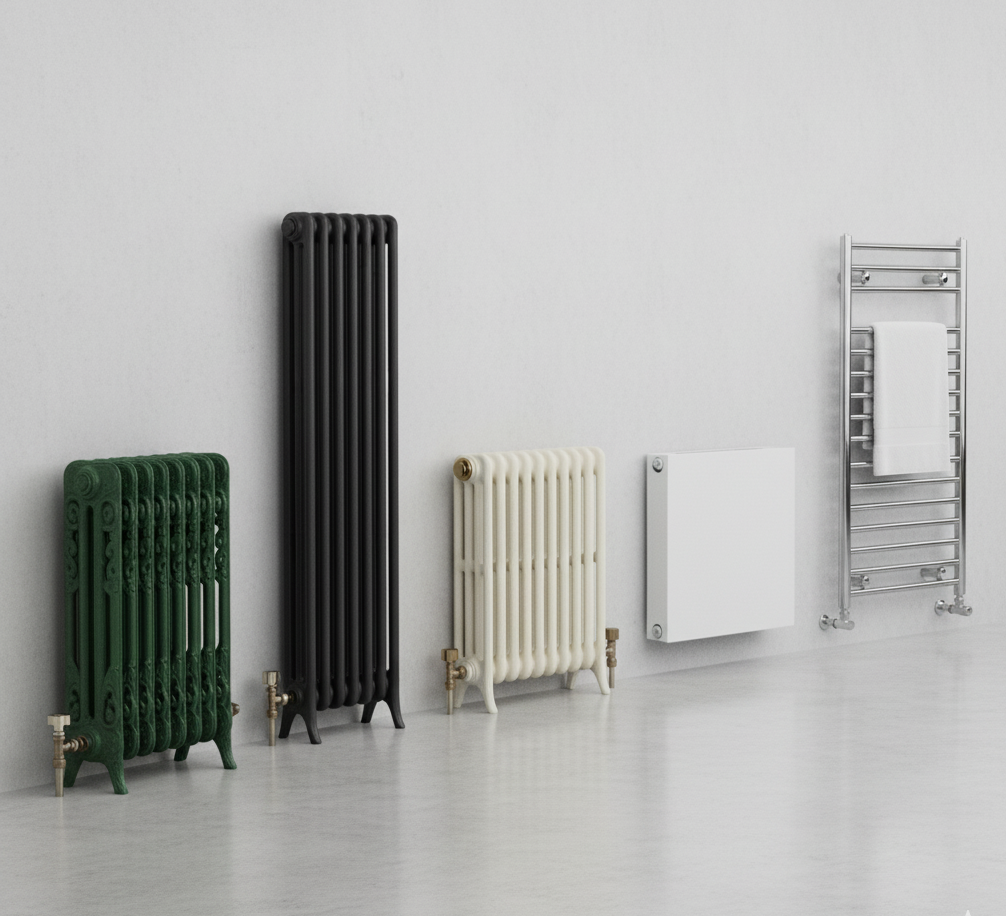Aluminium vs. Cast Iron Radiators: Which Material is Best for Efficiency and Style?

Is your home always chilly? This expert guide breaks down the great heating debate: Aluminium vs. Cast Iron radiators. We analyse heat-up times, running costs, and style to reveal the best material for your home's efficiency.
Are you tired of wearing a jumper indoors? Frustrated by a central heating system that feels both inefficient and punishingly expensive? When it comes time to upgrade, homeowners face a critical decision that impacts comfort and energy bills for decades: the responsive efficiency of modern aluminium or the timeless, radiant warmth of traditional cast iron?
As heating experts, we've seen countless UK homeowners make costly mistakes. The truth is, there is no single "best" material. The right material depends on your home's age, your insulation, your lifestyle, and your budget.
This guide will definitively cut through the myths. We will analyse the physics, running costs, and style implications to help you make an informed, expert choice. We'll compare the pros and cons of both, and even reveal a "best of both worlds" solution that is rapidly becoming the top choice for savvy renovators.
The Most Important Step You Can't Afford to Skip
Before you look at a single style, you must do one thing first. The single biggest mistake is choosing a radiator based on looks alone. A beautiful radiator that is too small for the room will never, ever keep you warm. One that is too big will waste energy and money.
The only place to start is with power, measured in BTUs (British Thermal Units). Every room has a unique BTU requirement based on its size, window type, insulation, and number of outside walls.
Don't guess your BTU needs. Use our comprehensive BTU calculator to get a precise, expert-level heat requirement for your room in seconds. This is the non-negotiable first step to an efficient home.

Aluminium vs. Cast Iron: A Quick Comparison
These two materials work in fundamentally different ways. Aluminium is a responsive sprinter, while cast iron is a marathon runner.
| Feature | Aluminium Radiators | Cast Iron Radiators |
|---|---|---|
| Heat-Up Time | Extremely Fast. A "super conductor" of heat. | Very Slow. Can take over 30 minutes to reach full temperature. |
| Heat Retention | Low. Cools down almost instantly when the heating is off. | Excellent. Stays warm for hours, providing a steady, gentle heat. |
| Heat Type | Convection. Primarily heats the air in the room. | Radiant. Heats objects and people directly for a more comfortable feel. |
| Weight & Installation | Very Lightweight. Easy to install, even on plasterboard walls. | Extremely Heavy. Requires solid floor/wall support and professional, often two-person, installation. |
| Efficiency Style | Responsive. Perfect for smart thermostats and "on-demand" heat. | Retentive. Ideal for maintaining a stable base temperature in hard-to-heat homes. |
| Lifespan | Typically 10-20 years. | A "buy-it-for-life" investment. Can last 50+ years, often a century. |
| Upfront Cost | Mid-to-High. | Very High. A significant investment in product and installation. |
Deep Dive: Aluminium Radiators (The Modern, Responsive Choice)
Aluminium radiators are the poster child for modern, energy-conscious heating. Their entire design is built around speed and responsiveness.
The "Get Warm Fast" Advantage
Aluminium is a "super conductor" of heat. Its thermal conductivity is 4-5 times better than cast iron. This means that seconds after your boiler fires up, that heat is being transferred into your room.
Furthermore, they use a much lower volume of water than older designs. Less water means your boiler works for a shorter time to reach the desired temperature, saving energy from the very start.
Efficiency as Control
A common myth is that aluminium's fast cool-down time is a disadvantage. In a modern, well-insulated home, it's a huge benefit. Cast iron can "overshoot" your thermostat's setting, continuing to pump out heat into a room that is already warm this is wasted energy.
Aluminium is the perfect partner for smart thermostats. It gives you heat exactly when you ask for it and stops the moment the room is comfortable, giving you precise control and lowering your bills.
Style & Installation
Because aluminium is so lightweight, installation is simpler, cheaper, and more versatile. They can be safely mounted on internal plasterboard walls, opening up new design possibilities. Aesthetically, they define the modern look available in sleek flat panels, stunning vertical designs, and contemporary finishes like anthracite grey and bold black.
Aluminium: Pros & Cons
- Pros: Heats up fastest, highly responsive, low water content (energy efficient), lightweight, perfect for smart thermostats, and ideal for modern homes.
- Cons: Cools down quickly (less effective in draughty homes), higher initial cost than basic steel, and a shorter lifespan than cast iron.
Deep Dive: Cast Iron Radiators (The Timeless, Comforting Choice)
Cast iron is the original radiator material, and for many, it still represents the pinnacle of home comfort. Its philosophy is the polar opposite of aluminium: it is about slow, steady, undeniable warmth.
A Different Kind of Warmth: Radiant vs. Convection
This is the most important concept to grasp. Aluminium and cast iron heat a room in fundamentally different ways.
- Convection Heat (Aluminium/Steel): These radiators work by heating the air. The hot air rises, cools, then falls, creating a "convection current". This can sometimes feel draughty and leave your feet cold while your head is warm.
- Radiant Heat (Cast Iron): Like the warmth from sunlight, cast iron emits radiant heat. These heat waves travel through the air and warm you, the furniture, and the walls directly. These warm objects then radiate their own heat, creating an all-encompassing, even, and deeply comfortable feeling.
Efficiency as Retention
Cast iron has a very high "thermal mass" it's a heat sink. While it takes a long time to heat up, it acts like a storage heater, holding that heat and gently releasing it for hours after your boiler has switched off. In an old, draughty, or high-ceilinged period property, this slow-release warmth is far more effective and comfortable than the "on-off" blast of a convection heater.
Style & Installation
A cast iron radiator is a piece of furniture. It's a "buy it for life" statement. With ornate, traditional, and industrial styles, they are a focal point in period renovations. However, this comes at a cost. They are incredibly heavy and almost always require floor mounts and specialist, two-person installation, which adds significantly to the price.
Cast Iron: Pros & Cons
- Pros: Unbeatable heat retention, provides superior radiant comfort, extremely durable (50+ years), and has a timeless, classic style.
- Cons: Very slow to heat up, extremely heavy and expensive to install, and has a very high upfront purchase cost.

The "Best of Both Worlds" Solution You Haven't Considered
This is the dilemma many homeowners face: "I love the look of cast iron, but I can't justify the cost, weight, and slow heat-up time."
If this sounds like you, there is an ideal solution: the Steel Column Radiator.
Modern steel column radiators are meticulously designed to capture that classic, "old school" or "vintage" cast iron aesthetic. However, because they are made from high-quality, durable mild steel, they heat up much faster and are significantly lighter and more affordable.
Actionable Tip: You get the timeless style of cast iron with the responsive, modern performance of steel. Explore our complete collection of cast iron style column radiators to find the perfect balance for your home.
Future-Proofing: What About Heat Pumps?
As the UK moves towards greener heating, this is a critical question. Air source heat pumps are low-temperature systems, meaning they work best with radiators that can efficiently transfer heat at lower water temperatures.
- Aluminium: This is an excellent partner for heat pumps. Its high conductivity and low water content mean it can effectively heat a room even with cooler water, making it a highly efficient, future-proof choice.
- Cast Iron: This is more complex. While it can work , it often requires specialist calculations and much larger, oversized radiators to get the same heat output, which can make an already expensive option even more costly.
Verdict: Aluminium is the simpler, safer, and more "plug-and-play" compatible material for low-temperature heat pump systems.
E-E-A-T: Expert Advice & Authoritative Sources
As experts, we believe in arming you with the best information. Don't just take our word for it—trust the industry leaders. For any major heating project, we recommend consulting guidelines from authoritative UK bodies:
- For Technical Design: The CIBSE Domestic Heating Design Guide is the UK's professional standard for heating engineers, covering topics like system design and correct radiator selection.
- For Practical Savings: The Energy Saving Trust provides impartial advice for homeowners. They confirm that simple, low-cost measures like adding radiator reflector panels behind radiators on external walls can reduce heat loss and save money on your bills.
The Final Verdict: Which Material is Right for You?
The best radiator is the one that fits your home, heating system, and lifestyle.
Choose Aluminium Radiators if...
...You have a modern, well-insulated home.
...You use (or plan to use) a smart thermostat for "on-demand" heating.
...You are installing a low-temperature system like a heat pump.
...You prioritise rapid heat-up times and sleek, modern design.
Choose Cast Iron Radiators if...
...You have a period property with high ceilings and potential draughts.
...You prioritise stable, "radiant" comfort and timeless style above all else.
...You have a significant budget for both the product and the complex, heavy-duty installation.
...You are making a "buy it for life" investment in a "forever home."
Conclusion: Your Next Steps to a Warmer, More Efficient Home
Choosing a new radiator is one of the most impactful upgrades you can make, affecting your home's comfort, style, and energy bills for years to come. The debate between aluminium and cast iron isn't about which is "better," but which is right for you.
Are you seeking the "get warm fast" responsiveness of aluminium, or the deep, "storage-heater" comfort of cast iron? Or, like many UK homeowners, are you looking for the perfect blend of both?
We've made the next steps simple.
Step 1: Get Your Numbers.
Before you do anything else, get your exact heat requirement. Use our free, expert-grade BTU Calculator.
Step 2: Find Your Perfect Match.
Armed with your BTU number, explore our curated collections. We highly recommend starting with our Column Radiators the "best of both worlds" solution that delivers classic style with modern efficiency.



